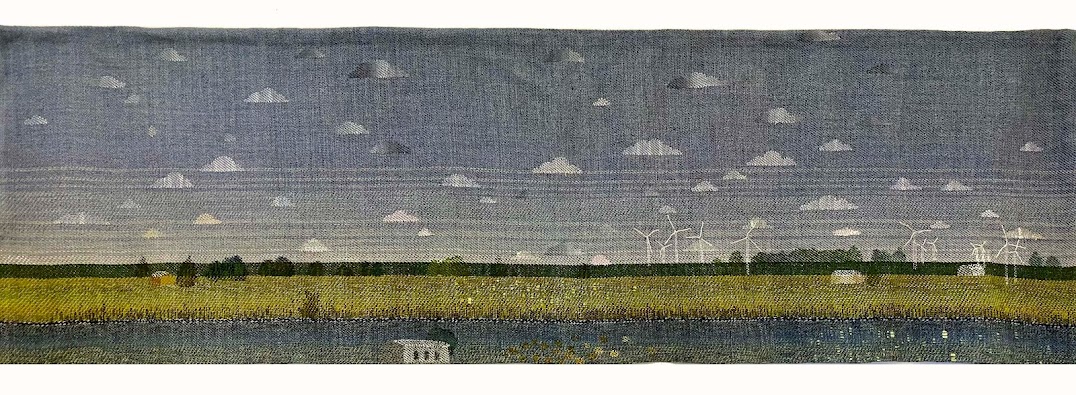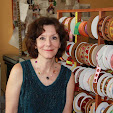I used the basic party dress pattern from The Party Dress Book by Mary Adams. I traced the bodice pattern pieces onto fusible interfacing, and placed each piece fusible side up on my ironing board (shown here covered with one of my old Crate & Barrel tea towels!).
By lifting up every other ribbon, I laid down the first row of weft ribbon. I pushed it hard up against the pins and made sure the flower motifs lined up.
I continued to weave in ribbon strips until the whole piece was woven, then I carefully pressed it with my iron, using the setting for polyester. You have to hold the iron in place in eavery spot for a few seconds so the fusible interfacing will bond to the ribbon.
The skirt looked easier to do: it was a full circle skirt, and I had an idea of radiating ribbon stripes stitched down to a fabric ground. I chose nylon netting as my under fabric, but that was a MISTAKE, I should have used something firmly woven and lightweight. The netting stretched out of shape and caused the ribbons to buckle. I lost count of the number of yards of ribbon I sewed down. I sewed most of them down the entire length, so I worked in groups, first laying out the reds like spokes of a wheel, then sewing, then adding color or pattern between all around & sewing down, etc. I probably would have done better to get more mathematical and stitch more pieces cut from the middle down and attach them first, then ending up with the ribbons running all the way down from the waist. It would have been less bulky at the top. But I have the temperament to think out sewing projects in my head, do minimal calculations, and then make it up as I go along!
I then constructed the dress, putting in a back zipper, cutting the hem evenly, and making a big frilly net petticoat to hold the skirt out. Around the hem, to help it to stand out more fully, I sewwed a ribbon edging. This is a cool thing about polyester: as this is a curved edge there is of course a differential in the lengths of the inner & outer curves. So you press the top edge of the ribbon (before sewing it down) to make it shrink evenly along its lengthe, then sew the longer bottom edge in place aroudn the skirt edge, and then sew the upper edge in place. You might still have to ease it a bit but the shrink-shaping works very well.
A beautiful friend modeled the dress for me but she won't let me show her face or her name, so thank you, Anonymous Lady! Soon we will have more photos of the dress to post online.
Thanks too to Renaissance Ribbons for donating the grosgrain and satin ribbons used in this project.













No comments:
Post a Comment